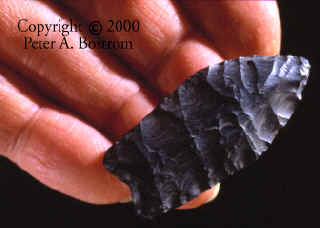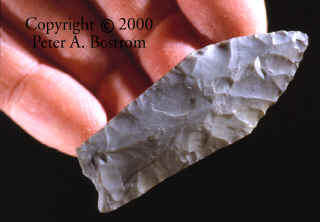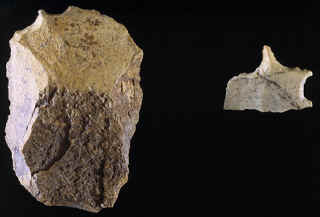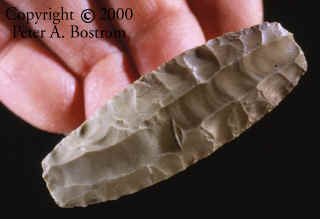|
2001 JUNE |
|
THE MESA SITE |
TEN VIEWS OF THE MESA SITE |
|
THE
MESA SITE
|
|
CLICK ON PICTURE
FOR LARGE DOUBLE EXPOSURE
This spear point is complete but has been heavily resharpened. It measures
2 11/16 inches long.
CLICK ON PICTURE
FOR LARGE DOUBLE EXPOSURE
This spear point is complete but has been heavily resharpened. So much so
that it may have been seen as no longer useful and finally discarded for a
newer point.
CLICK ON PICTURE
FOR LARGE DOUBLE EXPOSURE This spear point is complete but may have been resharpened at least once and the tip of the point appears to possibly have suffered some impact damage.
CLICK ON PICTURE
FOR LARGE DOUBLE EXPOSURE
This concave base spear point is complete but like several of the points
from this site has been heavily resharpened. One ear is also broken off.
CLICK ON PICTURE
FOR LARGE IMAGE
CLICK ON PICTURE
FOR LARGE DOUBLE EXPOSURE This is one of the most unique objects found on the Mesa site. It was found in a late northern Archaic micro-blade feature that dates to approximately 3500 years ago. Unlike the earlier features on this site this one was not associated with a hearth. 120 micro-blades were found in this area. Half of them are made of exotic materials brought into the area from somewhere else. This bipolar fluted object is not believed to be a micro-blade core. It's so uniformly flaked that it was apparently made for some specific purpose. No other similar artifacts have been discovered to compare it with so at this time its intended function is not understood. |
|
"REFERENCES"
|





















